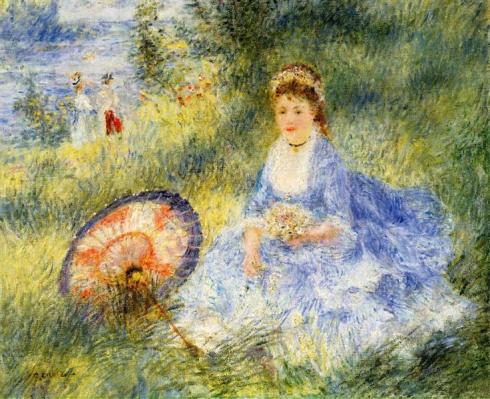“Nostalgia for the life of others. This is because, seen from the outside, another’s life forms a unit. Whereas ours, seen from the inside, seems broken up. We are still chasing after an illusion of unity.”
(Camus, Notebook IV (August/September, 1942)
 Pierre Bonnard, Rooftops, 1897
Pierre Bonnard, Rooftops, 1897
The voyeur in me delights in these two paintings by a French Post-Impressionist painter Pierre Bonnard. Gazing at the building, or a house, on the other side of the road, counting all the windows and balconies, wondering what secrets do the fancy facade and flimsy curtains hide, is there anything that awakens more curiosity and longing both at once? Painting “Rooftops” isn’t that exciting on its own; it just shows a roof of some Parisian building, roof windows and a little bit of blue sky. The scene would be much more exciting if it showed a woman undressing at the window, a couple kissing, or a murder taking place, but with the aid of our imagination we can fantasise about anything taking place in one of those flats. When I see a painting like this, I couldn’t care less about the architecture! My mind instantly starts fantasising about the people living there. Who are they and are their lives more exciting than mine? What secrets do the windows of their flats hide? What are they thinking about when they gaze at the other side of street? Gazing at other people’s windows, at the houses on the other side of the street reminds me of something that a character played by Daniel Auteuil tells a sad young girl Adele, played by Vanessa Paradis, in the film “La fille sur le pont”: “I’m going to tell you a story. Long ago, I lived on the even side of the street, at number 22. I gazed at the houses across the street thinking that people were happier, their rooms sunnier, their parties more fun. But in fact their rooms were darker and smaller. And they too gazed across the street. Because we always think that luck is what we don’t have.” Naturally, I have no curiosity or envy for the lives of people I know well because I know that their lives are as banal and boring as mine, but the mysterious faces whose names I know not, oh they are the ones about whom I can weave fantasies and project all my yearning and envy on.

Pierre Bonnard, Rue Tholozé (Montmartre in the Rain), 1897
Another Bonnard’s painting “Montmartre in the Rain”, painted in the same year as the “Rooftops”, also shows the buildings on the other side of the street with their glowing yellow windows. Each window holds a secret and even though the windows with the lights on are captivating and vibrant, the windows left in the darkness are even more mysterious; who is there in the darkness, a sad poet sitting on his bed, or secret lovers whispering secret words into each other’s ear? Bonnard must have been on a very high floor, third or fourth perhaps, to capture the scene in that perspective. I love the way Bonnard captured the magical atmosphere of glowing yellow lights and the wet pavements after rain. The strollers in the street bellow look like black blots. In “Rooftops” and “Montmartre at Night” Bonnard painted a view on the buildings on the other side of the street, but what about the inside of the flat and the people who live in it? Another Bonnard’s painting “Woman at the Window (Among the Seamstresses)”, painted in 1895, and a lovely pastel by Pissarro “At the Window, rue des Trois Frères”, painted in 1878, offer a view on what goes inside the flats, what secrets are hidden behind the curtains and windows. I bet the little girl in Pissarro’s painting would rather be exploring the parks and streets outside her house than be sitting there above the book, I bet she is eager to feel the sun and wind on her face and to taste life and not just read about it. And those drab, gloomy probably underpaid seamstresses in Bonnard’s paintings, I bet they would rather be strolling around free, roaming the streets and not sewing the dresses for evening parties that they will never attend, touching the silk fabric that they will never get to wear. They must be gazing longingly at those free passers by and wondering where they are going? And thus the circle continues, there is always the illusion, as the title of Milan Kundera’s novel says, that life is elsewhere….

Camille Pissarro, At the Window, rue des Trois Frères, 1878, Pastel on cream wove pastel paper

Pierre Bonnard, Woman at the Window (Among the Seamstresses), c. 1895
Tags: art, Bonnard, Camille Pissarro, Camus, life, longing, nostalgia for life of others, Painting, Pierre Bonnard, Pissarro, Post-Impressionism, voyeur, window
 Renoir, Young Woman with a Japanese Umbrella, 1876
Renoir, Young Woman with a Japanese Umbrella, 1876






